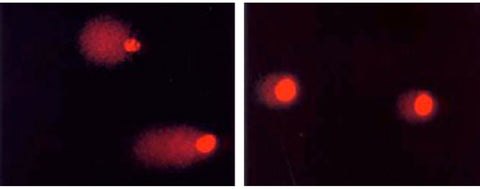By Dan Fryda
Over exposure to the sun without protection leads to wrinkles, brown spots and eventually the potential of cancer. The simple truth is that physical blocks work best, this includes clothing and especially hats. As far as SPF products are concerned, those with mineral blocks such as micronized titanium dioxide or zinc oxide (as opposed to nano) provide the safest form of protection for anyone who is about to spend hours exposed to the sun and the elements.
DNA Damage
Comet Assay Test:

The DNA on left is like a comet having a ball and a “tail” of damaged strands of DNA. The DNA on the right shows normal healthy DNA that has been repaired by plankton enzymes.
Even with a solar protective shield, there may be some damage from sun exposure. Harmful rays can disturb the bonds of DNA to create malformed strands called dimers. The body’s repair mechanisms attempt to correct the damage, but it’s a long process. Marine plankton contains enzymes that can correct that damage within 2-4 hours of application. These ‘photolyase’ enzymes are remarkable in that they are dormant until exposed to sunlight which stimulates them to repair DNA. Tests conducted on human volunteers by Heinrich Heine University in Germany provided strong evidence to support this claim, where biopsies from human volunteers revealed a 50% improvement within two hours. These enzymes are found in our Marine Repair Cream.
Brown Algae Polyphenols
Marine algae refers to all of plants that dwell in the oceans, from microscopic plankton that create the vast “meadows of the sea” to giant kelp that grow 6 inches a day and can attain a length of over 180 feet. Within their seawater environment they are constantly exposed to strong ultra-violet radiation and harsh climate conditions. These marine plants have evolved a network of defense mechanisms to defend their DNA including anti-inflammatory polysaccharides, super antioxidant vitamins and polyphenols, DNA repairing photolyase enzymes and a concentration of vital minerals all working in synergistic balance.
Marine algae like laminaria and fucus offer a vast treasure of antioxidants that defend our skin’s cells from the attacks of ultra violet radiation as well as free radicals and pollutants. Laminaria is a giant kelp found in the North Atlantic and harvested off the coast of Iceland and Brittany. Living in pristine conditions, this kelp is renowned for its wealth of polyphenols—one of nature’s most powerful antioxidants. Research conducted at Ohio State University and the University of South Carolina suggest that brown algae polyphenols harvested from laminaria provide strong anti-carcinogenic properties in the treatment of skin cancer.
Beta and alpha-carotenes provide additional antioxidant protection and give this kelp its characteristic brownish green coloring. Of the carotenoids, astaxanthin is the most powerful and has been described as nature’s sunscreen. Other antioxidants found in our seaweed include super lutein, lycopene, vitamin C, vitamin E and fucoidan. These are supported by ions of minerals and trace elements to neutralize free radicals before they can damage nucleic DNA.
Nature’s Anti-Inflammatory Remedies
For those who experience mild sun burn and redness, marine algae provide anti-inflammatory actives. Omega-7 fatty acids, marine polysaccharides and astaxanthin help to relieve the discomfort of over-exposure to the sun. Our labs have formulated seaweed-based mists and gels working in synergy with CBD and aromatic essential oils to cool the skin and restore it to a normal tone.






